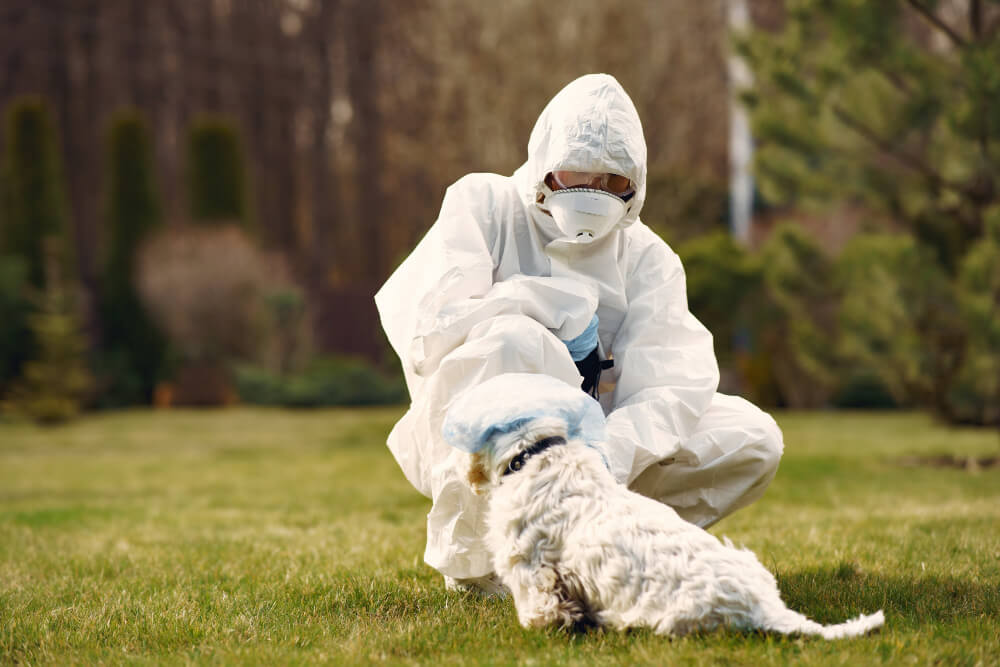Distemper is a serious, contagious disease that affects dogs, especially puppies and unvaccinated dogs. It’s a scary illness, but with the right information, you can protect your furry friend from this dangerous virus. Let’s dive into what distemper is, its symptoms, prevention tips, and treatment options.

What Is Canine Distemper?
Canine distemper is caused by the canine distemper virus (CDV), which affects a dog’s respiratory, gastrointestinal, and nervous systems. Often compared to measles in humans, distemper is highly contagious and can spread rapidly through dog populations, particularly where there are unvaccinated animals.
This virus doesn’t only target dogs; it can infect other animals, like ferrets, raccoons, and even large wild animals such as lions and tigers. However, domestic dogs are highly susceptible, and this disease can be fatal, especially for young or unvaccinated pets.
How Do Dogs Catch Distemper?
The virus spreads through bodily fluids, including saliva, urine, blood, and respiratory droplets. Here’s how a dog could get infected:
- Direct Contact: Dogs catch the virus by coming into contact with an infected animal’s bodily fluids, whether through sniffing, licking, or even playing.
- Airborne Particles: The virus can spread through the air, so if a sick dog coughs or sneezes near a healthy dog, the healthy dog can become infected.
- Contaminated Surfaces: Bowls, beds, toys, and even food can harbor the virus. Since the virus can survive on surfaces for a short time, shared spaces in kennels, shelters, or dog parks can facilitate its spread.
Symptoms of Distemper in Dogs
Distemper symptoms can vary significantly between dogs, as it affects multiple bodily systems. In some cases, symptoms might start mild but can worsen rapidly. Here’s a breakdown of the primary symptoms:
Early Stage Symptoms
- Eye Discharge: Watery or pus-like discharge from the eyes is one of the first signs.
- Fever: An infected dog might develop a high fever, usually within 3-6 days after exposure.
- Nasal Discharge: A runny nose, often accompanied by coughing or sneezing.
- Lethargy and Lack of Appetite: Dogs with distemper often show signs of fatigue and may lose interest in food and activities.
Gastrointestinal Symptoms
As the virus progresses, it often moves to the gastrointestinal system, causing:
- Vomiting: Dogs might vomit frequently.
- Diarrhea: This can lead to dehydration, making it even harder for the dog’s immune system to fight off the virus.
Neurological Symptoms
One of the most troubling aspects of distemper is how it affects the nervous system. If the virus reaches this stage, symptoms can include:
- Seizures: Dogs may experience full-body seizures or twitching, often described as a “chewing gum” movement of the jaw.
- Tremors and Muscle Twitching: Uncontrollable movements or spasms, which can become more severe over time.
- Paralysis: Some dogs lose the ability to move certain limbs or become completely paralyzed.
- Behavioral Changes: Anxiety, confusion, and aggression can develop if the virus impacts the brain.

How to Prevent Distemper in Dogs
Prevention is the best way to protect your dog from distemper, and it starts with vaccination. Here’s what you should know:
Vaccination
- Puppies: Puppies should receive their first distemper vaccine at around 6-8 weeks old, with booster shots every 3-4 weeks until they’re about 16 weeks old.
- Adult Dogs: Adult dogs should receive booster shots as directed by your veterinarian, typically every 1-3 years.
- Unvaccinated Dogs: If your dog is an adult and unvaccinated, it’s never too late to start. Speak with your vet about getting your dog vaccinated.
Avoiding High-Risk Environments
- Socialization with Care: While it’s important for puppies to socialize, be cautious about bringing them to public areas or around unfamiliar dogs until they’re fully vaccinated.
- Dog Parks and Daycares: Only take vaccinated dogs to parks and daycares, as these environments can carry a higher risk of exposure.
- Shelters and Rescues: If you adopt a new pet, check their vaccination records and follow up with your vet on any needed shots.
Diagnosing Distemper in Dogs
If you suspect your dog has distemper, it’s essential to get them to the vet right away. Diagnosis typically involves:
- Clinical Signs: Vets look at symptoms and assess exposure history.
- Laboratory Tests: Blood tests and swabs from nasal or eye discharge may be used to confirm the presence of the virus.
Treatment for Distemper in Dogs
There is no specific cure for distemper, so treatment focuses on supportive care to manage symptoms.
Supportive Care
- Hydration: Intravenous fluids may be given to prevent dehydration, especially if the dog is vomiting or has diarrhea.
- Medications: Antibiotics can help manage secondary bacterial infections, while anti-seizure medications may help if the dog is experiencing neurological symptoms.
- Nutritional Support: Dogs with distemper may need a specialized diet or feeding methods to ensure they’re getting enough nutrients.
Isolation and Comfort
Since distemper is highly contagious, infected dogs should be isolated from other animals. Providing a comfortable, stress-free environment with plenty of rest can aid in recovery.
Prognosis and Recovery: What to Expect
The outcome for dogs with distemper can vary. Some dogs recover completely, while others may have lingering neurological effects, like tremors or muscle twitches, for the rest of their lives. In severe cases, particularly if the virus has spread to the brain, the disease can be fatal.
Dogs that recover from distemper often build up immunity and are less likely to contract the virus again. However, they might need extra support, as they can have lasting effects from the illness.
Final Thoughts on Distemper in Dogs
Distemper is a serious, preventable disease that all dog owners should be aware of. The best way to protect your dog is through vaccination and keeping them away from high-risk environments until they’re fully vaccinated. If you suspect your dog may have been exposed to or is showing symptoms of distemper, don’t hesitate to reach out to your veterinarian.
Your dog relies on you for their health and safety, and understanding diseases like distemper can make a world of difference in keeping them happy, healthy, and by your side for years to come!







